Dongwon Kim
Democratizing Text-to-Image Masked Generative Models with Compact Text-Aware One-Dimensional Tokens
Jan 13, 2025



Abstract:Image tokenizers form the foundation of modern text-to-image generative models but are notoriously difficult to train. Furthermore, most existing text-to-image models rely on large-scale, high-quality private datasets, making them challenging to replicate. In this work, we introduce Text-Aware Transformer-based 1-Dimensional Tokenizer (TA-TiTok), an efficient and powerful image tokenizer that can utilize either discrete or continuous 1-dimensional tokens. TA-TiTok uniquely integrates textual information during the tokenizer decoding stage (i.e., de-tokenization), accelerating convergence and enhancing performance. TA-TiTok also benefits from a simplified, yet effective, one-stage training process, eliminating the need for the complex two-stage distillation used in previous 1-dimensional tokenizers. This design allows for seamless scalability to large datasets. Building on this, we introduce a family of text-to-image Masked Generative Models (MaskGen), trained exclusively on open data while achieving comparable performance to models trained on private data. We aim to release both the efficient, strong TA-TiTok tokenizers and the open-data, open-weight MaskGen models to promote broader access and democratize the field of text-to-image masked generative models.
Improving Text-based Person Search via Part-level Cross-modal Correspondence
Dec 31, 2024



Abstract:Text-based person search is the task of finding person images that are the most relevant to the natural language text description given as query. The main challenge of this task is a large gap between the target images and text queries, which makes it difficult to establish correspondence and distinguish subtle differences across people. To address this challenge, we introduce an efficient encoder-decoder model that extracts coarse-to-fine embedding vectors which are semantically aligned across the two modalities without supervision for the alignment. There is another challenge of learning to capture fine-grained information with only person IDs as supervision, where similar body parts of different individuals are considered different due to the lack of part-level supervision. To tackle this, we propose a novel ranking loss, dubbed commonality-based margin ranking loss, which quantifies the degree of commonality of each body part and reflects it during the learning of fine-grained body part details. As a consequence, it enables our method to achieve the best records on three public benchmarks.
1.58-bit FLUX
Dec 24, 2024Abstract:We present 1.58-bit FLUX, the first successful approach to quantizing the state-of-the-art text-to-image generation model, FLUX.1-dev, using 1.58-bit weights (i.e., values in {-1, 0, +1}) while maintaining comparable performance for generating 1024 x 1024 images. Notably, our quantization method operates without access to image data, relying solely on self-supervision from the FLUX.1-dev model. Additionally, we develop a custom kernel optimized for 1.58-bit operations, achieving a 7.7x reduction in model storage, a 5.1x reduction in inference memory, and improved inference latency. Extensive evaluations on the GenEval and T2I Compbench benchmarks demonstrate the effectiveness of 1.58-bit FLUX in maintaining generation quality while significantly enhancing computational efficiency.
Robust Bayesian Optimization via Localized Online Conformal Prediction
Nov 26, 2024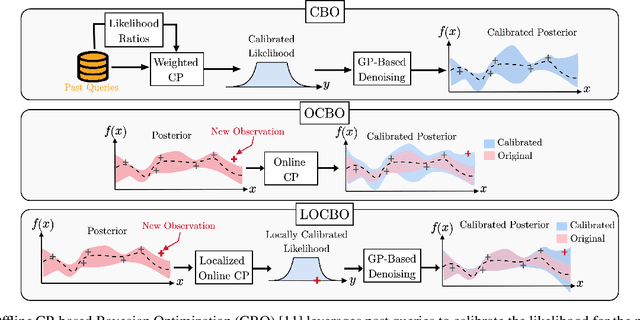
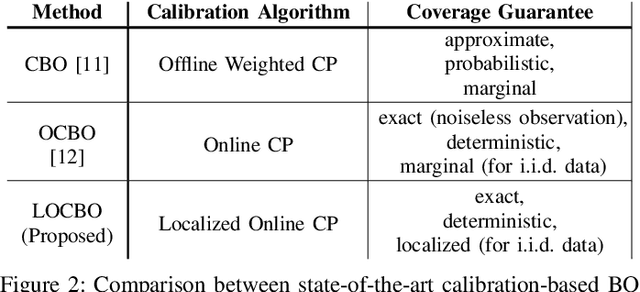
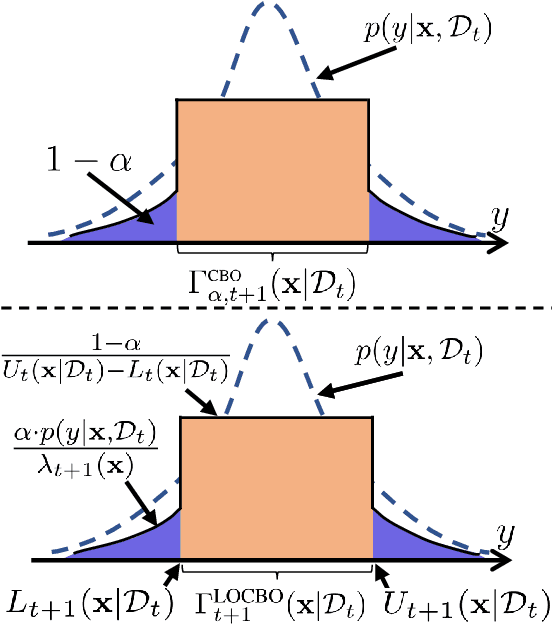
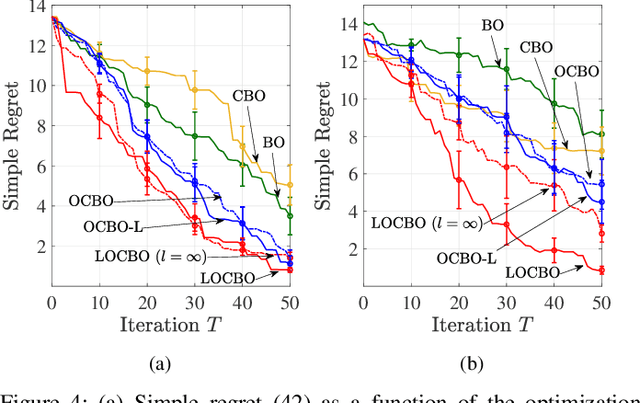
Abstract:Bayesian optimization (BO) is a sequential approach for optimizing black-box objective functions using zeroth-order noisy observations. In BO, Gaussian processes (GPs) are employed as probabilistic surrogate models to estimate the objective function based on past observations, guiding the selection of future queries to maximize utility. However, the performance of BO heavily relies on the quality of these probabilistic estimates, which can deteriorate significantly under model misspecification. To address this issue, we introduce localized online conformal prediction-based Bayesian optimization (LOCBO), a BO algorithm that calibrates the GP model through localized online conformal prediction (CP). LOCBO corrects the GP likelihood based on predictive sets produced by LOCBO, and the corrected GP likelihood is then denoised to obtain a calibrated posterior distribution on the objective function. The likelihood calibration step leverages an input-dependent calibration threshold to tailor coverage guarantees to different regions of the input space. Under minimal noise assumptions, we provide theoretical performance guarantees for LOCBO's iterates that hold for the unobserved objective function. These theoretical findings are validated through experiments on synthetic and real-world optimization tasks, demonstrating that LOCBO consistently outperforms state-of-the-art BO algorithms in the presence of model misspecification.
Bootstrapping Top-down Information for Self-modulating Slot Attention
Nov 04, 2024


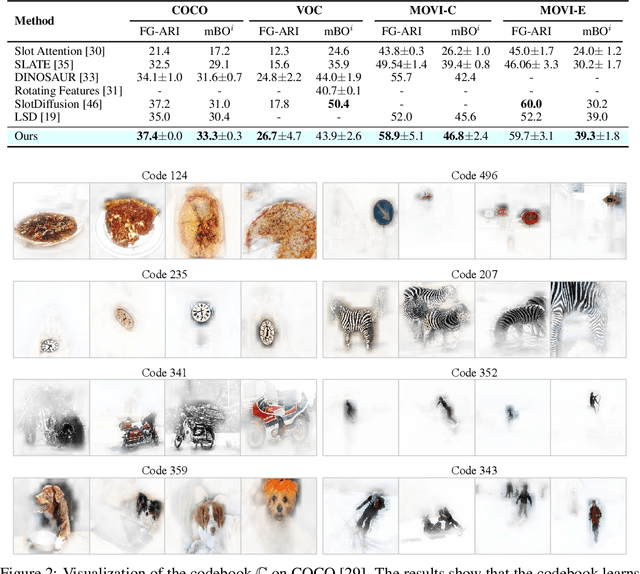
Abstract:Object-centric learning (OCL) aims to learn representations of individual objects within visual scenes without manual supervision, facilitating efficient and effective visual reasoning. Traditional OCL methods primarily employ bottom-up approaches that aggregate homogeneous visual features to represent objects. However, in complex visual environments, these methods often fall short due to the heterogeneous nature of visual features within an object. To address this, we propose a novel OCL framework incorporating a top-down pathway. This pathway first bootstraps the semantics of individual objects and then modulates the model to prioritize features relevant to these semantics. By dynamically modulating the model based on its own output, our top-down pathway enhances the representational quality of objects. Our framework achieves state-of-the-art performance across multiple synthetic and real-world object-discovery benchmarks.
Shatter and Gather: Learning Referring Image Segmentation with Text Supervision
Aug 29, 2023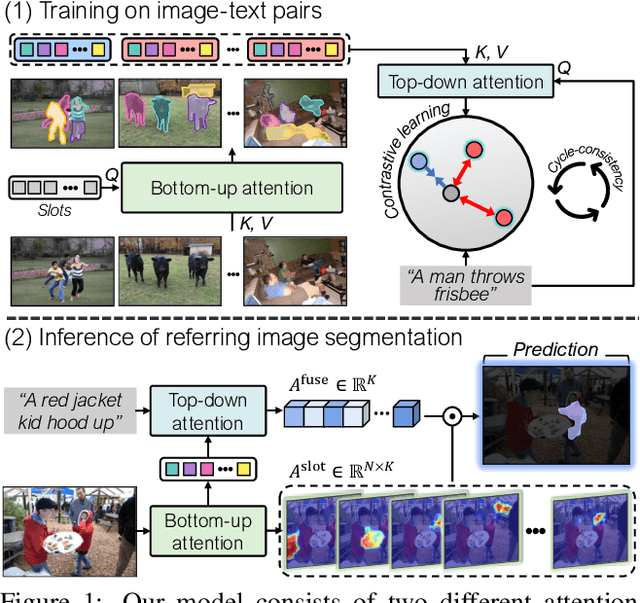

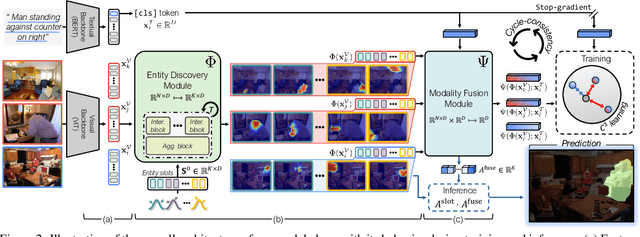
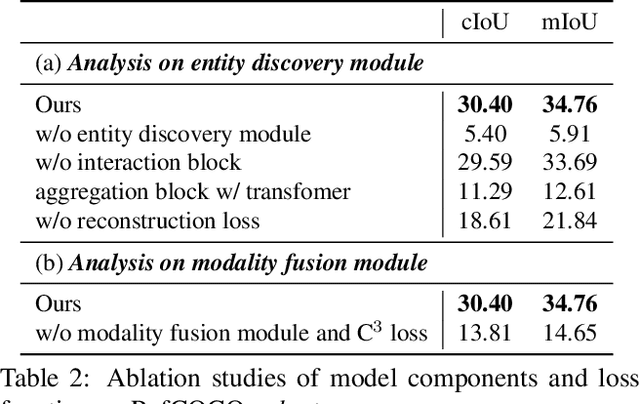
Abstract:Referring image segmentation, the task of segmenting any arbitrary entities described in free-form texts, opens up a variety of vision applications. However, manual labeling of training data for this task is prohibitively costly, leading to lack of labeled data for training. We address this issue by a weakly supervised learning approach using text descriptions of training images as the only source of supervision. To this end, we first present a new model that discovers semantic entities in input image and then combines such entities relevant to text query to predict the mask of the referent. We also present a new loss function that allows the model to be trained without any further supervision. Our method was evaluated on four public benchmarks for referring image segmentation, where it clearly outperformed the existing method for the same task and recent open-vocabulary segmentation models on all the benchmarks.
Improving Cross-Modal Retrieval with Set of Diverse Embeddings
Nov 30, 2022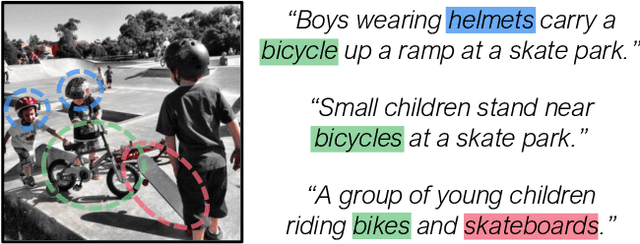
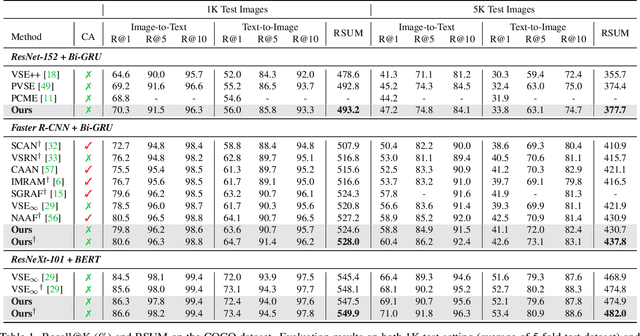

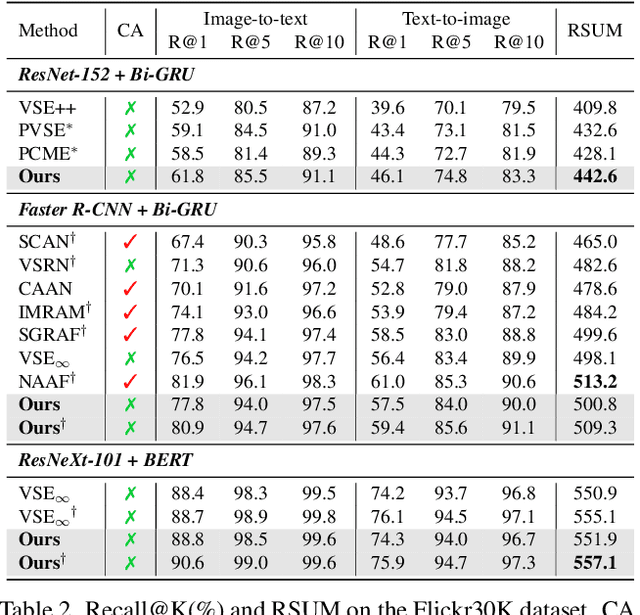
Abstract:Cross-modal retrieval across image and text modalities is a challenging task due to its inherent ambiguity: An image often exhibits various situations, and a caption can be coupled with diverse images. Set-based embedding has been studied as a solution to this problem. It seeks to encode a sample into a set of different embedding vectors that capture different semantics of the sample. In this paper, we present a novel set-based embedding method, which is distinct from previous work in two aspects. First, we present a new similarity function called smooth-Chamfer similarity, which is designed to alleviate the side effects of existing similarity functions for set-based embedding. Second, we propose a novel set prediction module to produce a set of embedding vectors that effectively captures diverse semantics of input by the slot attention mechanism. Our method is evaluated on the COCO and Flickr30K datasets across different visual backbones, where it outperforms existing methods including ones that demand substantially larger computation at inference.
Self-Taught Metric Learning without Labels
May 04, 2022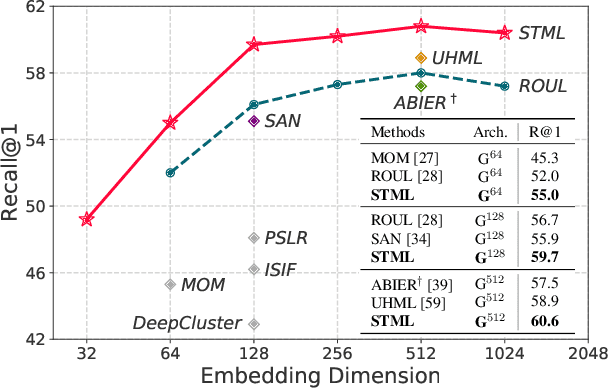
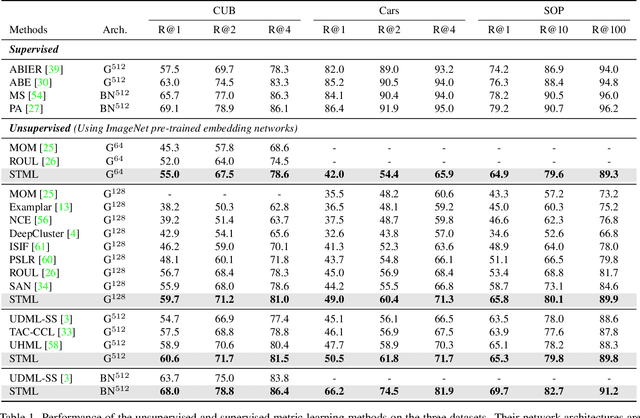
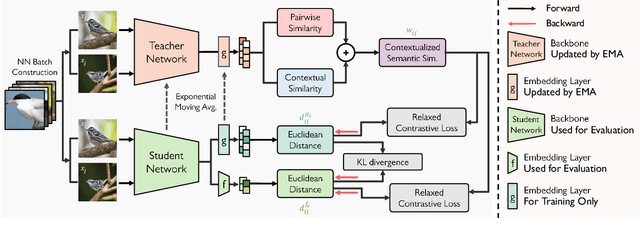
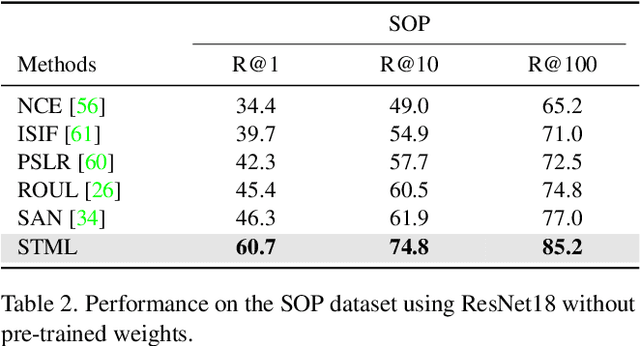
Abstract:We present a novel self-taught framework for unsupervised metric learning, which alternates between predicting class-equivalence relations between data through a moving average of an embedding model and learning the model with the predicted relations as pseudo labels. At the heart of our framework lies an algorithm that investigates contexts of data on the embedding space to predict their class-equivalence relations as pseudo labels. The algorithm enables efficient end-to-end training since it demands no off-the-shelf module for pseudo labeling. Also, the class-equivalence relations provide rich supervisory signals for learning an embedding space. On standard benchmarks for metric learning, it clearly outperforms existing unsupervised learning methods and sometimes even beats supervised learning models using the same backbone network. It is also applied to semi-supervised metric learning as a way of exploiting additional unlabeled data, and achieves the state of the art by boosting performance of supervised learning substantially.
ReSTR: Convolution-free Referring Image Segmentation Using Transformers
Mar 31, 2022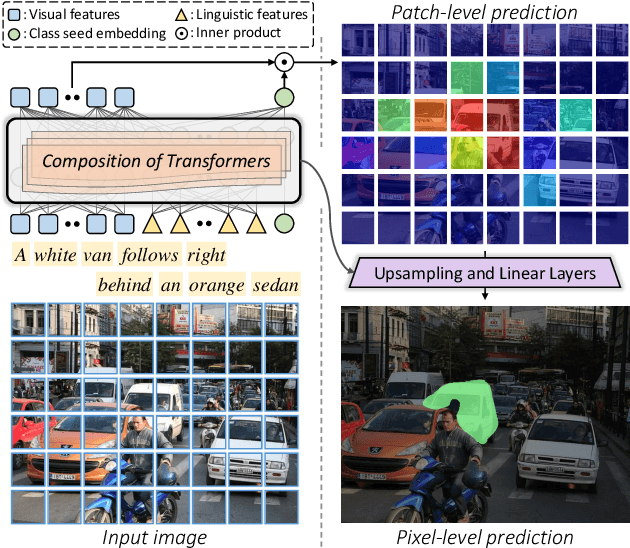
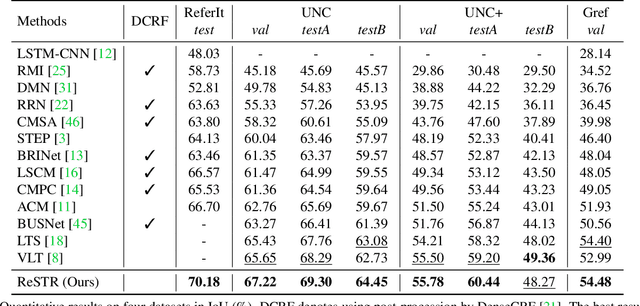
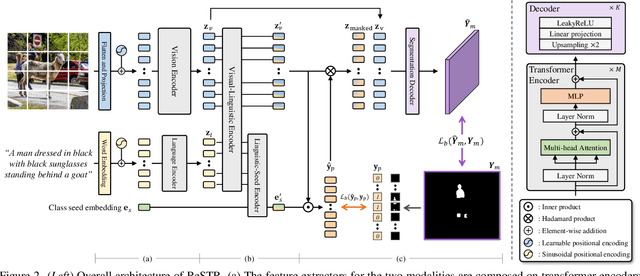
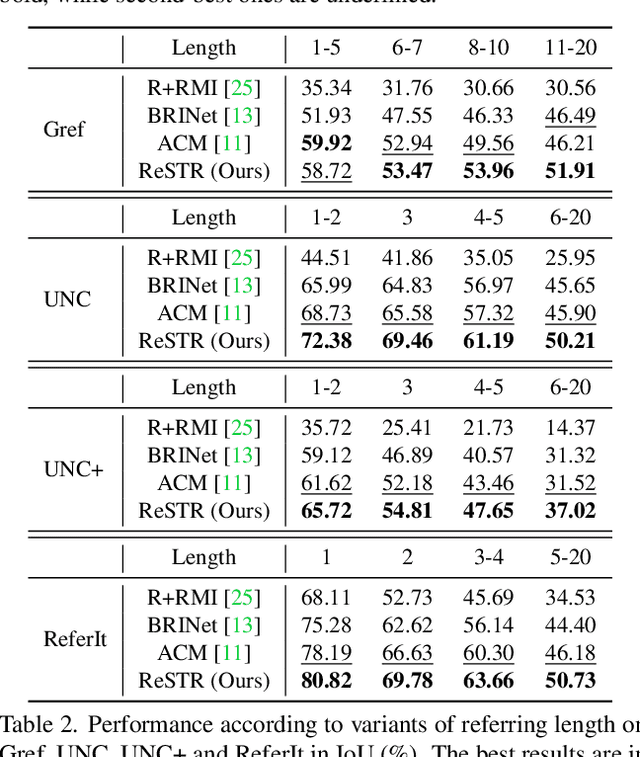
Abstract:Referring image segmentation is an advanced semantic segmentation task where target is not a predefined class but is described in natural language. Most of existing methods for this task rely heavily on convolutional neural networks, which however have trouble capturing long-range dependencies between entities in the language expression and are not flexible enough for modeling interactions between the two different modalities. To address these issues, we present the first convolution-free model for referring image segmentation using transformers, dubbed ReSTR. Since it extracts features of both modalities through transformer encoders, it can capture long-range dependencies between entities within each modality. Also, ReSTR fuses features of the two modalities by a self-attention encoder, which enables flexible and adaptive interactions between the two modalities in the fusion process. The fused features are fed to a segmentation module, which works adaptively according to the image and language expression in hand. ReSTR is evaluated and compared with previous work on all public benchmarks, where it outperforms all existing models.
Embedding Transfer with Label Relaxation for Improved Metric Learning
Mar 27, 2021
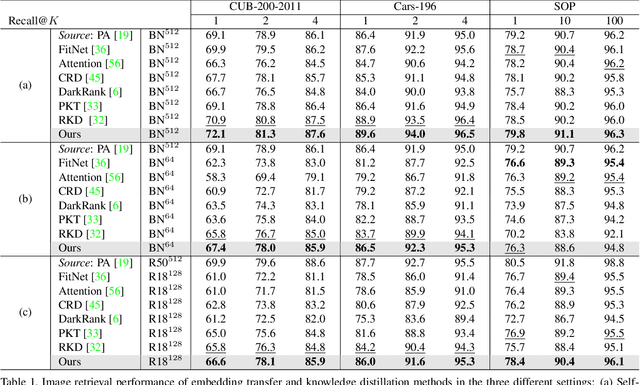
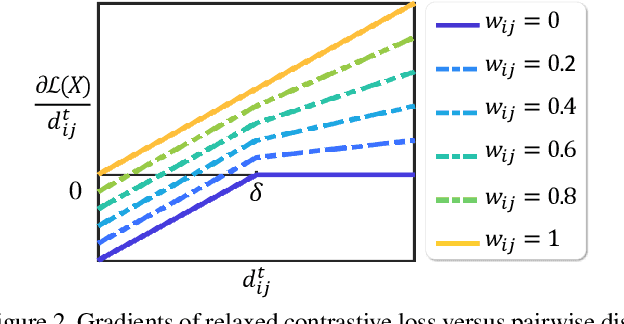
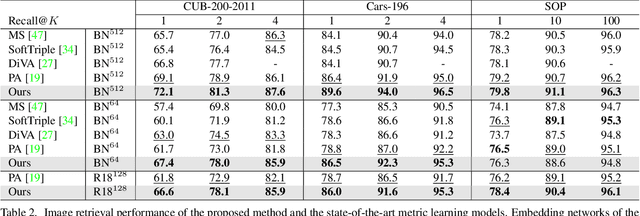
Abstract:This paper presents a novel method for embedding transfer, a task of transferring knowledge of a learned embedding model to another. Our method exploits pairwise similarities between samples in the source embedding space as the knowledge, and transfers them through a loss used for learning target embedding models. To this end, we design a new loss called relaxed contrastive loss, which employs the pairwise similarities as relaxed labels for inter-sample relations. Our loss provides a rich supervisory signal beyond class equivalence, enables more important pairs to contribute more to training, and imposes no restriction on manifolds of target embedding spaces. Experiments on metric learning benchmarks demonstrate that our method largely improves performance, or reduces sizes and output dimensions of target models effectively. We further show that it can be also used to enhance quality of self-supervised representation and performance of classification models. In all the experiments, our method clearly outperforms existing embedding transfer techniques.
 Add to Chrome
Add to Chrome Add to Firefox
Add to Firefox Add to Edge
Add to Edge